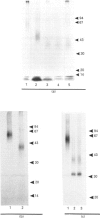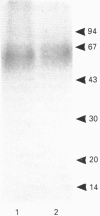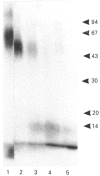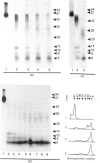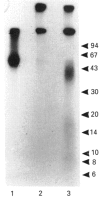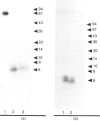Abstract
We report new structural data about the rat liver angiotensin II receptor, which belongs to the AT1 subclass. This receptor has been purified at analytical or semi-preparative levels by a previously described strategy involving its photolabelling with a biotinylated azido probe and selective adsorption of the covalent probe-receptor complexes to immobilized streptavidin [Marie, Seyer, Lombard, Desarnaud, Aumelas, Jard and Bonnafous (1990) Biochemistry 29, 8943-8950]. Chemical or enzymic deglycosylation of the purified receptor has shown a shift in its molecular mass from 65 kDa to 40 kDa. Fragmentation of the purified receptor was carried out with V8 protease from Staphylococcus aureus, CNBr and trypsin. It was possible to find trypsin-treatment conditions which allowed production of a 6 kDa probe-fragment complex with a satisfactory yield. Attempts to localize this small fragment (5 kDa after subtraction of the probe contribution) in the recently published rat AT1 receptor sequence are reported. As expected, this fragment is not glycosylated; moreover, its further fragmentation by CNBr induces a very slight decrease in its size. These data support the hypothesis that a receptor sequence comprising the third transmembrane domain and adjacent portions of extra- and intracellular loops is involved in photolabelling by the C-terminal azidophenylalanine of the angiotensin-derived probe. These preliminary results are discussed in terms of future prospects for the characterization of hormone-binding domains of angiotensin II receptors.
Full text
PDF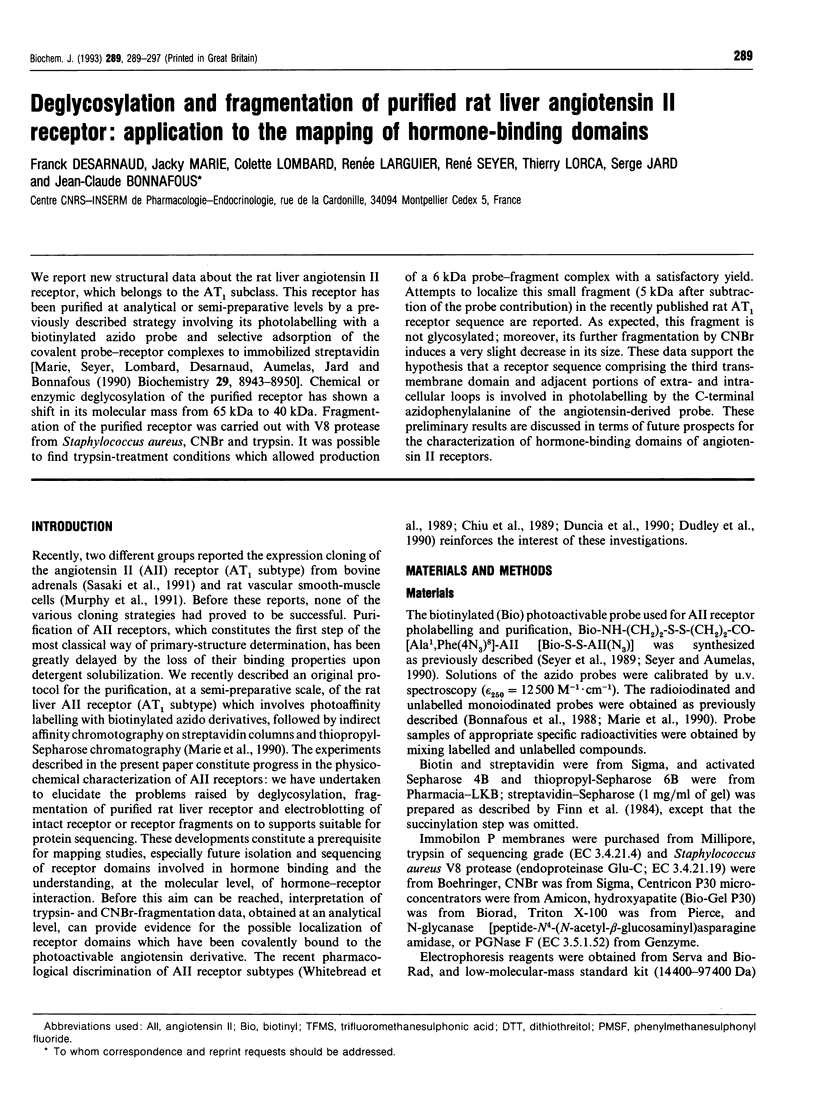
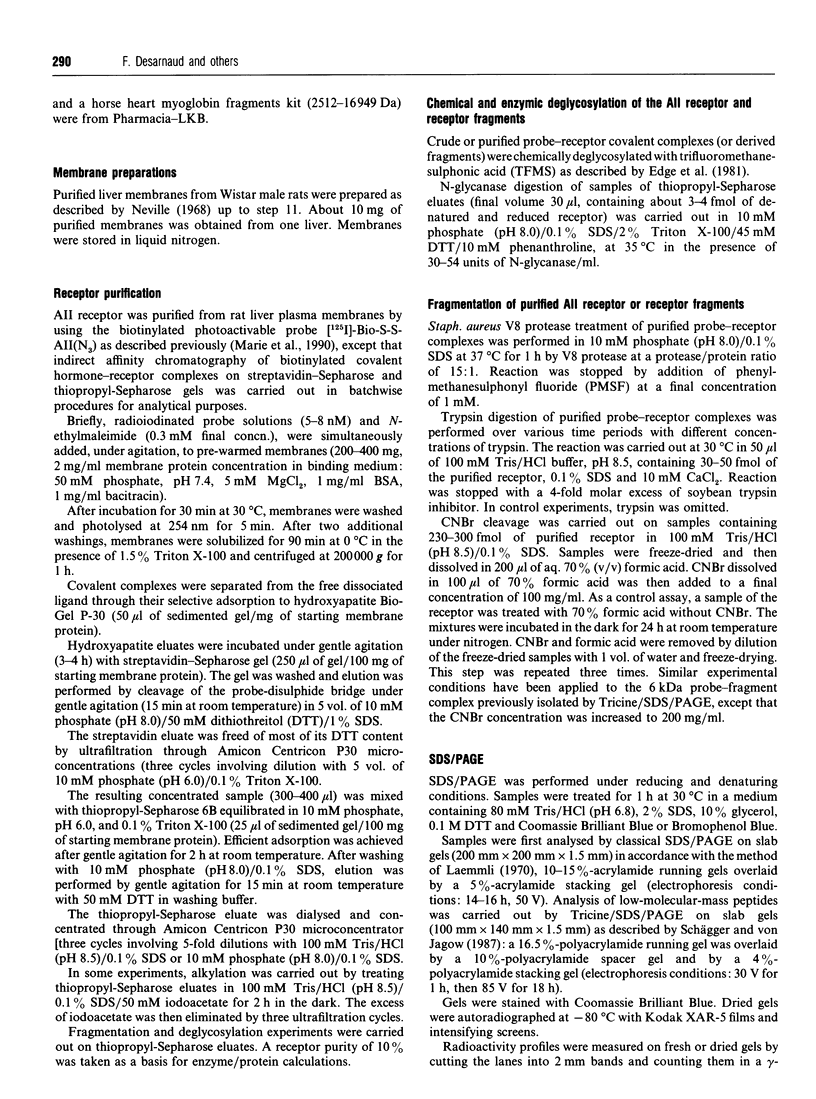
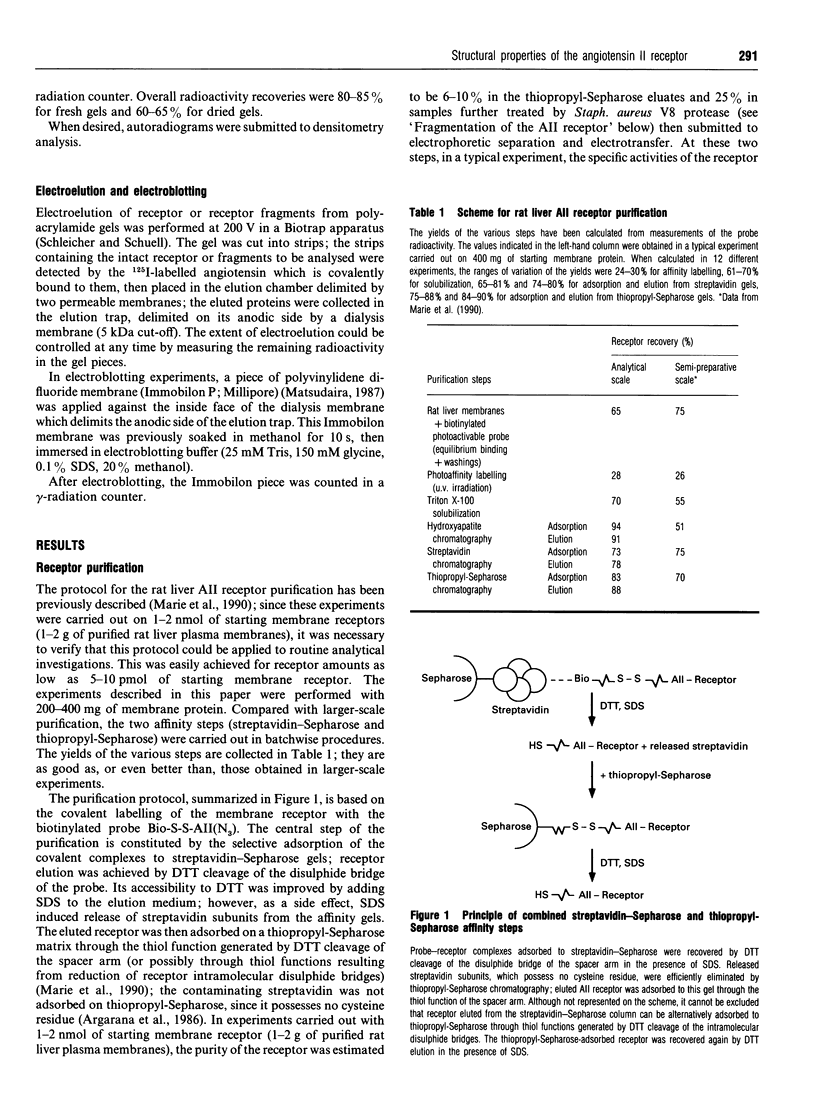
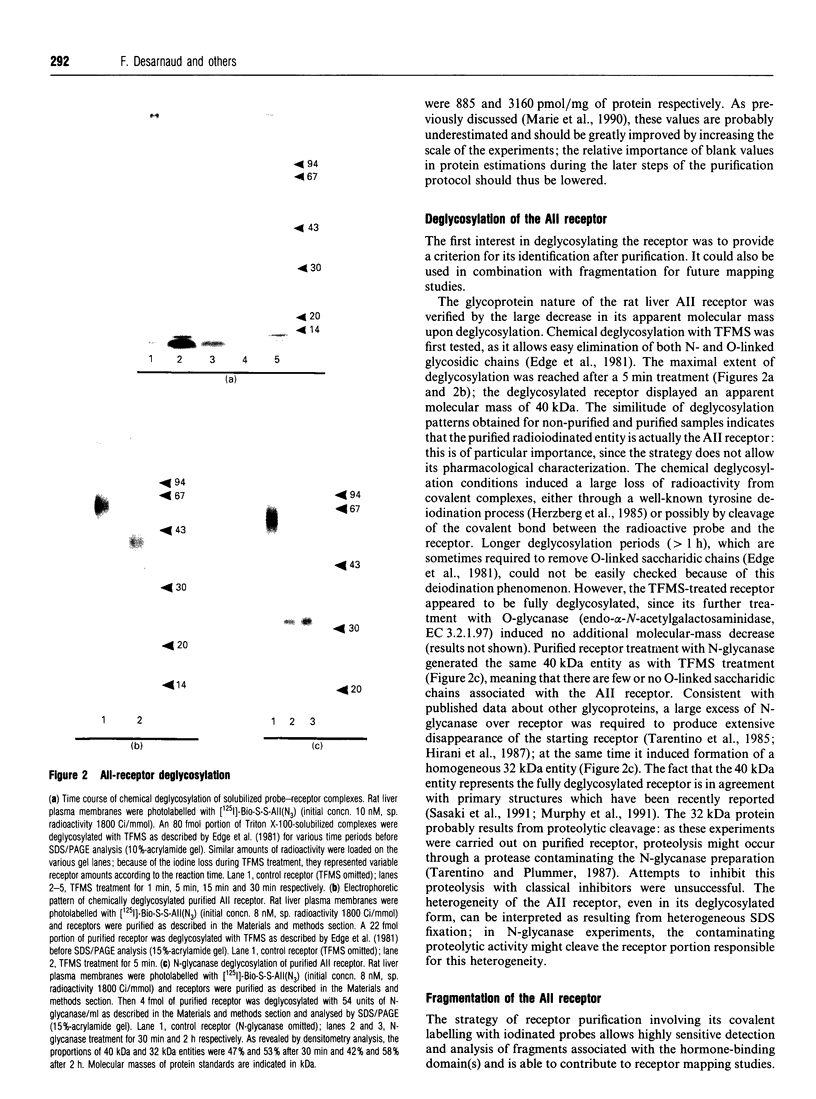
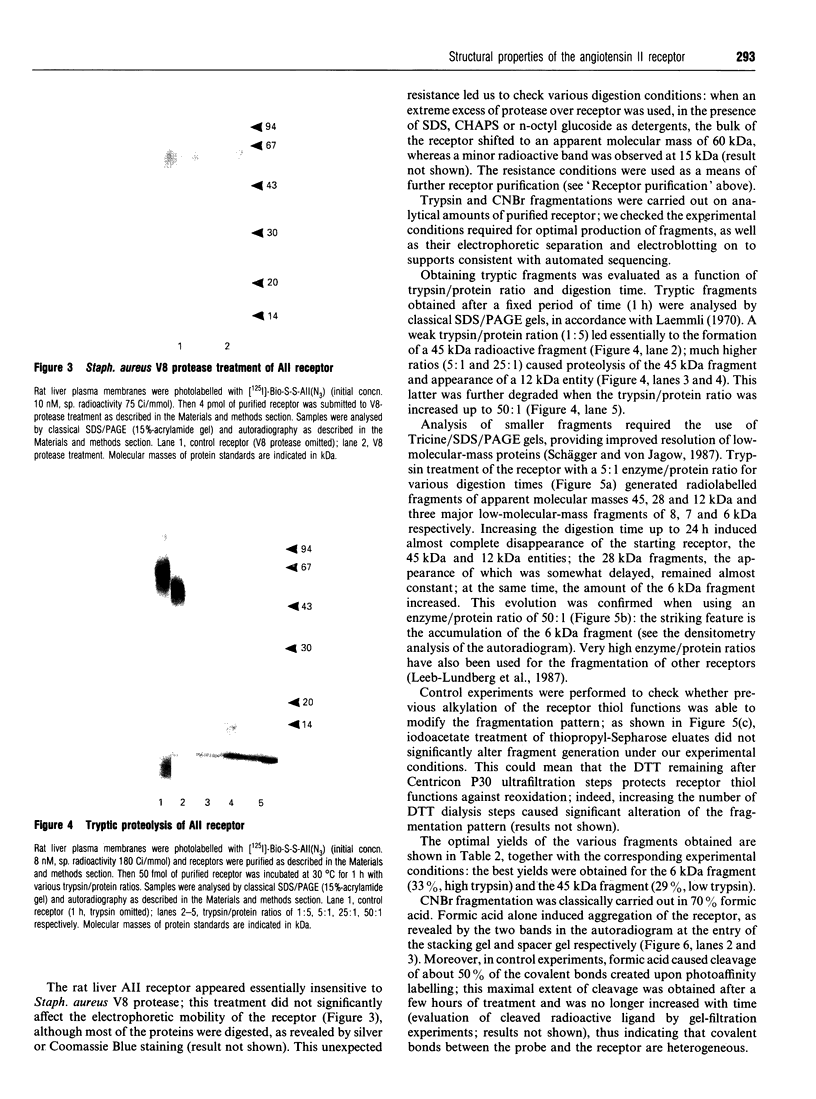
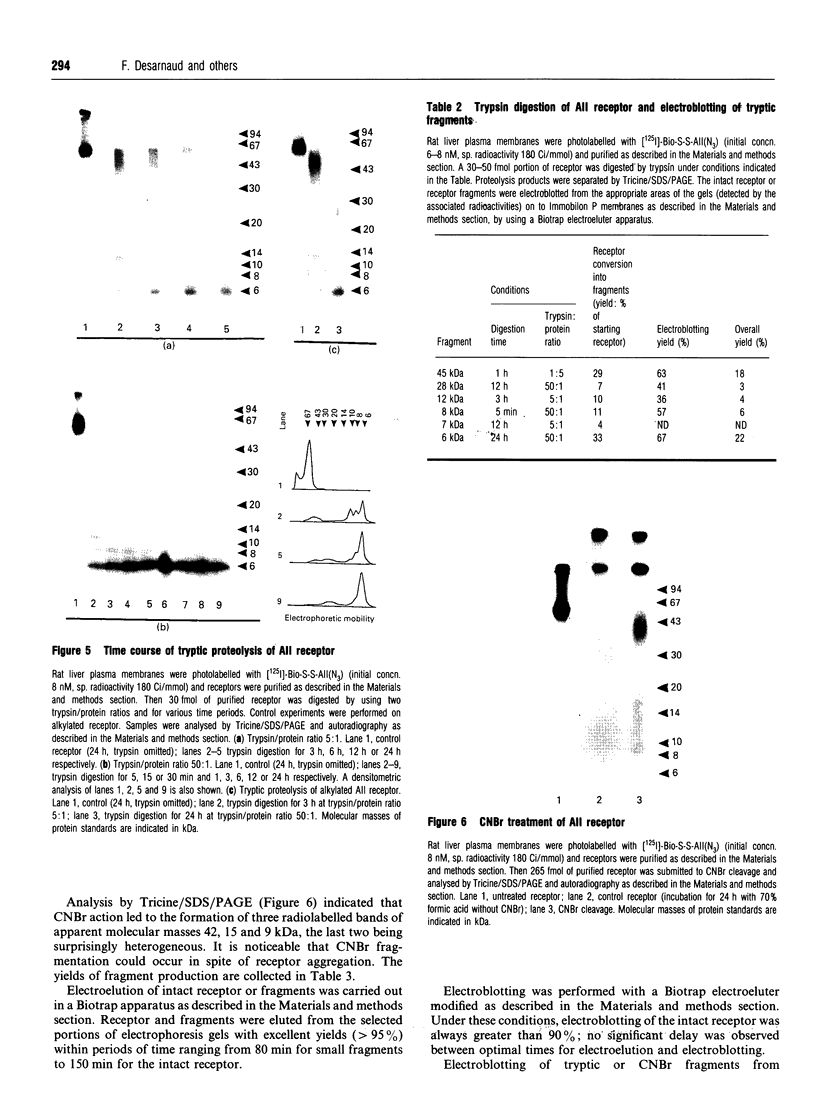
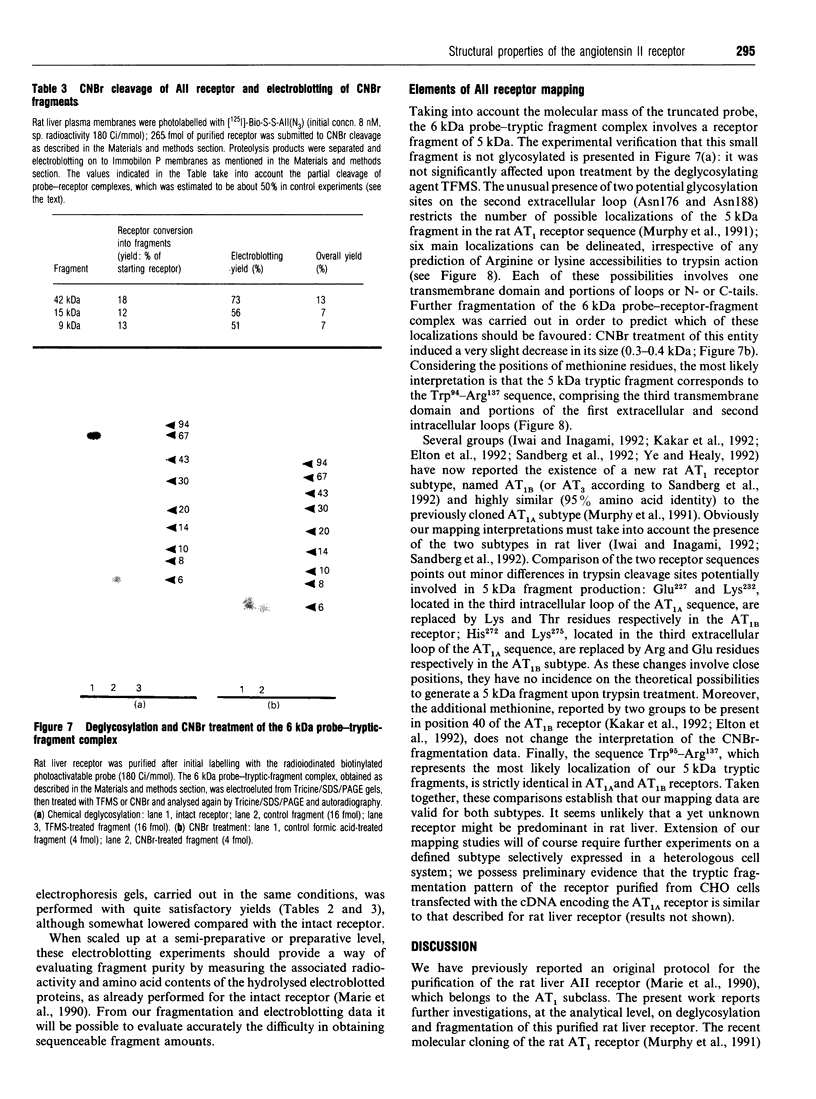
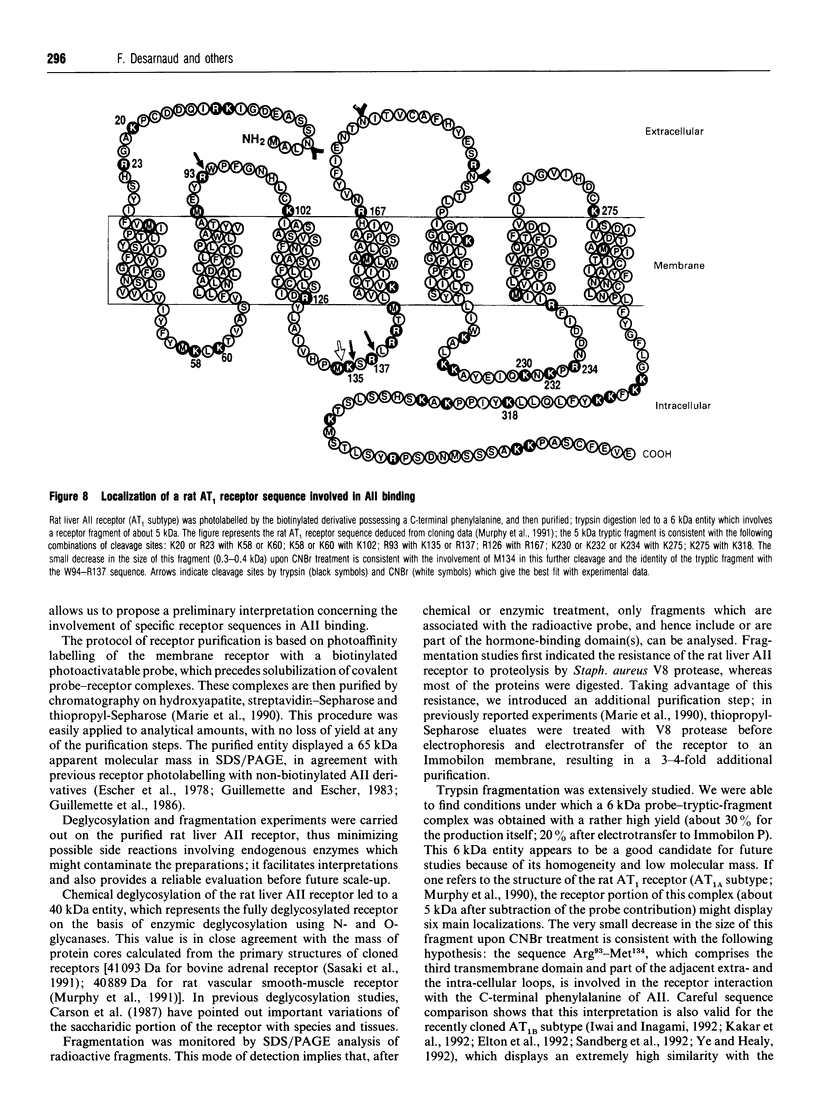
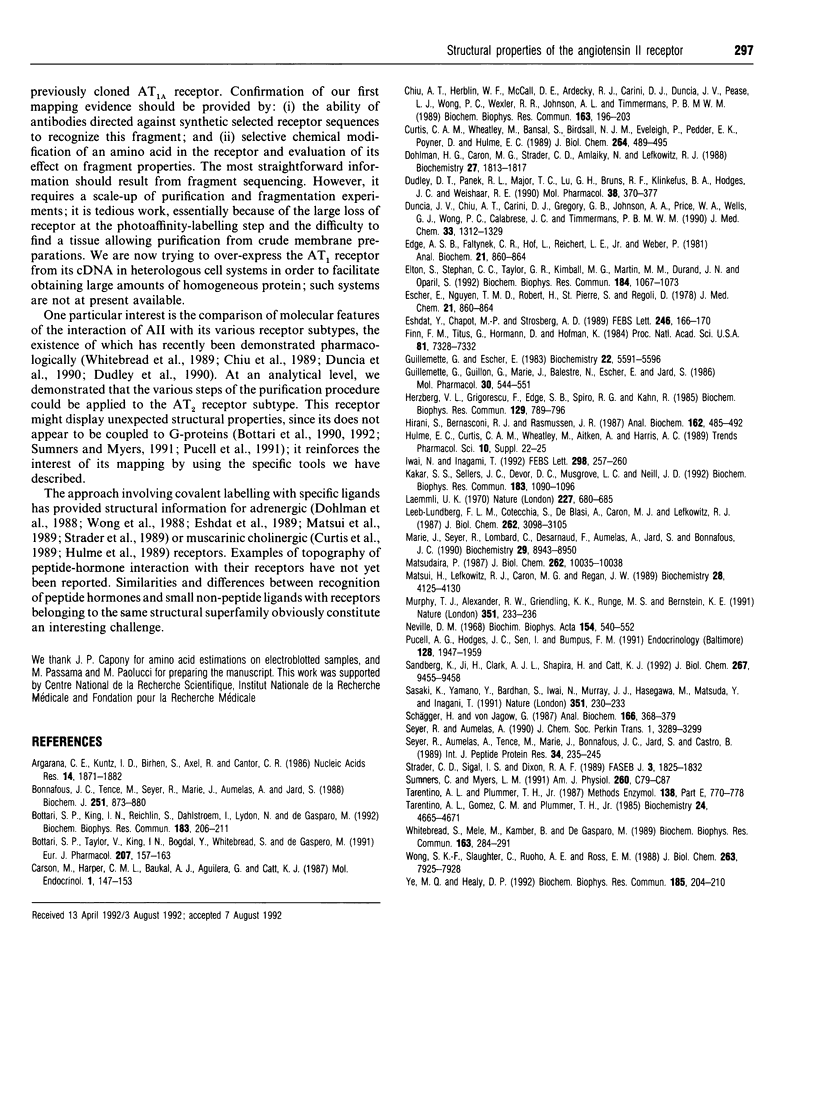
Images in this article
Selected References
These references are in PubMed. This may not be the complete list of references from this article.
- Argaraña C. E., Kuntz I. D., Birken S., Axel R., Cantor C. R. Molecular cloning and nucleotide sequence of the streptavidin gene. Nucleic Acids Res. 1986 Feb 25;14(4):1871–1882. doi: 10.1093/nar/14.4.1871. [DOI] [PMC free article] [PubMed] [Google Scholar]
- Bonnafous J. C., Tence M., Seyer R., Marie J., Aumelas A., Jard S. New probes for angiotensin II receptors. Synthesis, radioiodination and biological properties of biotinylated and haptenated angiotensin derivatives. Biochem J. 1988 May 1;251(3):873–880. doi: 10.1042/bj2510873. [DOI] [PMC free article] [PubMed] [Google Scholar]
- Bottari S. P., King I. N., Reichlin S., Dahlstroem I., Lydon N., de Gasparo M. The angiotensin AT2 receptor stimulates protein tyrosine phosphatase activity and mediates inhibition of particulate guanylate cyclase. Biochem Biophys Res Commun. 1992 Feb 28;183(1):206–211. doi: 10.1016/0006-291x(92)91629-5. [DOI] [PubMed] [Google Scholar]
- Bottari S. P., Taylor V., King I. N., Bogdal Y., Whitebread S., de Gasparo M. Angiotensin II AT2 receptors do not interact with guanine nucleotide binding proteins. Eur J Pharmacol. 1991 Jun 19;207(2):157–163. doi: 10.1016/0922-4106(91)90091-u. [DOI] [PubMed] [Google Scholar]
- Carson M. C., Harper C. M., Baukal A. J., Aguilera G., Catt K. J. Physicochemical characterization of photoaffinity-labeled angiotensin II receptors. Mol Endocrinol. 1987 Feb;1(2):147–153. doi: 10.1210/mend-1-2-147. [DOI] [PubMed] [Google Scholar]
- Chiu A. T., Herblin W. F., McCall D. E., Ardecky R. J., Carini D. J., Duncia J. V., Pease L. J., Wong P. C., Wexler R. R., Johnson A. L. Identification of angiotensin II receptor subtypes. Biochem Biophys Res Commun. 1989 Nov 30;165(1):196–203. doi: 10.1016/0006-291x(89)91054-1. [DOI] [PubMed] [Google Scholar]
- Curtis C. A., Wheatley M., Bansal S., Birdsall N. J., Eveleigh P., Pedder E. K., Poyner D., Hulme E. C. Propylbenzilylcholine mustard labels an acidic residue in transmembrane helix 3 of the muscarinic receptor. J Biol Chem. 1989 Jan 5;264(1):489–495. [PubMed] [Google Scholar]
- Dohlman H. G., Caron M. G., Strader C. D., Amlaiky N., Lefkowitz R. J. Identification and sequence of a binding site peptide of the beta 2-adrenergic receptor. Biochemistry. 1988 Mar 22;27(6):1813–1817. doi: 10.1021/bi00406a002. [DOI] [PubMed] [Google Scholar]
- Dudley D. T., Panek R. L., Major T. C., Lu G. H., Bruns R. F., Klinkefus B. A., Hodges J. C., Weishaar R. E. Subclasses of angiotensin II binding sites and their functional significance. Mol Pharmacol. 1990 Sep;38(3):370–377. [PubMed] [Google Scholar]
- Duncia J. V., Chiu A. T., Carini D. J., Gregory G. B., Johnson A. L., Price W. A., Wells G. J., Wong P. C., Calabrese J. C., Timmermans P. B. The discovery of potent nonpeptide angiotensin II receptor antagonists: a new class of potent antihypertensives. J Med Chem. 1990 May;33(5):1312–1329. doi: 10.1021/jm00167a007. [DOI] [PubMed] [Google Scholar]
- Elton T. S., Stephan C. C., Taylor G. R., Kimball M. G., Martin M. M., Durand J. N., Oparil S. Isolation of two distinct type I angiotensin II receptor genes. Biochem Biophys Res Commun. 1992 Apr 30;184(2):1067–1073. doi: 10.1016/0006-291x(92)90700-u. [DOI] [PubMed] [Google Scholar]
- Escher E. H., Nguyen T. M., Robert H., St-Pierre S. A., Regoli D. C. Photoaffinity labeling of the angiotensin II receptor. 1. Synthesis and biological activities of the labeling peptides. J Med Chem. 1978 Sep;21(9):860–864. doi: 10.1021/jm00207a004. [DOI] [PubMed] [Google Scholar]
- Eshdat Y., Chapot M. P., Strosberg A. D. Chemical characterization of ligand binding site fragments from turkey beta-adrenergic receptor. FEBS Lett. 1989 Mar 27;246(1-2):166–170. doi: 10.1016/0014-5793(89)80276-5. [DOI] [PubMed] [Google Scholar]
- Finn F. M., Titus G., Horstman D., Hofmann K. Avidin-biotin affinity chromatography: application to the isolation of human placental insulin receptor. Proc Natl Acad Sci U S A. 1984 Dec;81(23):7328–7332. doi: 10.1073/pnas.81.23.7328. [DOI] [PMC free article] [PubMed] [Google Scholar]
- Guillemette G., Escher E. Analysis of the adrenal angiotensin II receptor with the photoaffinity labeling method. Biochemistry. 1983 Nov 22;22(24):5591–5596. doi: 10.1021/bi00293a021. [DOI] [PubMed] [Google Scholar]
- Guillemette G., Guillon G., Marie J., Balestre M. N., Escher E., Jard S. High yield photoaffinity labeling of angiotensin II receptors. Mol Pharmacol. 1986 Dec;30(6):544–551. [PubMed] [Google Scholar]
- Herzberg V. L., Grigorescu F., Edge A. S., Spiro R. G., Kahn C. R. Characterization of insulin receptor carbohydrate by comparison of chemical and enzymatic deglycosylation. Biochem Biophys Res Commun. 1985 Jun 28;129(3):789–796. doi: 10.1016/0006-291x(85)91961-8. [DOI] [PubMed] [Google Scholar]
- Hirani S., Bernasconi R. J., Rasmussen J. R. Use of N-glycanase to release asparagine-linked oligosaccharides for structural analysis. Anal Biochem. 1987 May 1;162(2):485–492. doi: 10.1016/0003-2697(87)90424-6. [DOI] [PubMed] [Google Scholar]
- Iwai N., Inagami T. Identification of two subtypes in the rat type I angiotensin II receptor. FEBS Lett. 1992 Feb 24;298(2-3):257–260. doi: 10.1016/0014-5793(92)80071-n. [DOI] [PubMed] [Google Scholar]
- Kakar S. S., Sellers J. C., Devor D. C., Musgrove L. C., Neill J. D. Angiotensin II type-1 receptor subtype cDNAs: differential tissue expression and hormonal regulation. Biochem Biophys Res Commun. 1992 Mar 31;183(3):1090–1096. doi: 10.1016/s0006-291x(05)80302-x. [DOI] [PubMed] [Google Scholar]
- Laemmli U. K. Cleavage of structural proteins during the assembly of the head of bacteriophage T4. Nature. 1970 Aug 15;227(5259):680–685. doi: 10.1038/227680a0. [DOI] [PubMed] [Google Scholar]
- Leeb-Lundberg L. M., Cotecchia S., DeBlasi A., Caron M. G., Lefkowitz R. J. Regulation of adrenergic receptor function by phosphorylation. I. Agonist-promoted desensitization and phosphorylation of alpha 1-adrenergic receptors coupled to inositol phospholipid metabolism in DDT1 MF-2 smooth muscle cells. J Biol Chem. 1987 Mar 5;262(7):3098–3105. [PubMed] [Google Scholar]
- Marie J., Seyer R., Lombard C., Desarnaud F., Aumelas A., Jard S., Bonnafous J. C. Affinity chromatography purification of angiotensin II receptor using photoactivable biotinylated probes. Biochemistry. 1990 Sep 25;29(38):8943–8950. doi: 10.1021/bi00490a009. [DOI] [PubMed] [Google Scholar]
- Matsudaira P. Sequence from picomole quantities of proteins electroblotted onto polyvinylidene difluoride membranes. J Biol Chem. 1987 Jul 25;262(21):10035–10038. [PubMed] [Google Scholar]
- Matsui H., Lefkowitz R. J., Caron M. G., Regan J. W. Localization of the fourth membrane spanning domain as a ligand binding site in the human platelet alpha 2-adrenergic receptor. Biochemistry. 1989 May 2;28(9):4125–4130. doi: 10.1021/bi00435a075. [DOI] [PubMed] [Google Scholar]
- Murphy T. J., Alexander R. W., Griendling K. K., Runge M. S., Bernstein K. E. Isolation of a cDNA encoding the vascular type-1 angiotensin II receptor. Nature. 1991 May 16;351(6323):233–236. doi: 10.1038/351233a0. [DOI] [PubMed] [Google Scholar]
- Neville D. M., Jr Isolation of an organ specific protein antigen from cell-surface membrane of rat liver. Biochim Biophys Acta. 1968 Apr 9;154(3):540–552. doi: 10.1016/0005-2795(68)90014-7. [DOI] [PubMed] [Google Scholar]
- Pucell A. G., Hodges J. C., Sen I., Bumpus F. M., Husain A. Biochemical properties of the ovarian granulosa cell type 2-angiotensin II receptor. Endocrinology. 1991 Apr;128(4):1947–1959. doi: 10.1210/endo-128-4-1947. [DOI] [PubMed] [Google Scholar]
- Sandberg K., Ji H., Clark A. J., Shapira H., Catt K. J. Cloning and expression of a novel angiotensin II receptor subtype. J Biol Chem. 1992 May 15;267(14):9455–9458. [PubMed] [Google Scholar]
- Sasaki K., Yamano Y., Bardhan S., Iwai N., Murray J. J., Hasegawa M., Matsuda Y., Inagami T. Cloning and expression of a complementary DNA encoding a bovine adrenal angiotensin II type-1 receptor. Nature. 1991 May 16;351(6323):230–233. doi: 10.1038/351230a0. [DOI] [PubMed] [Google Scholar]
- Schägger H., von Jagow G. Tricine-sodium dodecyl sulfate-polyacrylamide gel electrophoresis for the separation of proteins in the range from 1 to 100 kDa. Anal Biochem. 1987 Nov 1;166(2):368–379. doi: 10.1016/0003-2697(87)90587-2. [DOI] [PubMed] [Google Scholar]
- Seyer R., Aumelas A., Tence M., Marie J., Bonnafous J. C., Jard S., Castro B. Synthesis of a biotinylated, iodinatable, and photoactivatable probe for angiotensin receptors. Int J Pept Protein Res. 1989 Sep;34(3):235–245. doi: 10.1111/j.1399-3011.1989.tb00236.x. [DOI] [PubMed] [Google Scholar]
- Strader C. D., Sigal I. S., Dixon R. A. Structural basis of beta-adrenergic receptor function. FASEB J. 1989 May;3(7):1825–1832. doi: 10.1096/fasebj.3.7.2541037. [DOI] [PubMed] [Google Scholar]
- Sumners C., Myers L. M. Angiotensin II decreases cGMP levels in neuronal cultures from rat brain. Am J Physiol. 1991 Jan;260(1 Pt 1):C79–C87. doi: 10.1152/ajpcell.1991.260.1.C79. [DOI] [PubMed] [Google Scholar]
- Tarentino A. L., Gómez C. M., Plummer T. H., Jr Deglycosylation of asparagine-linked glycans by peptide:N-glycosidase F. Biochemistry. 1985 Aug 13;24(17):4665–4671. doi: 10.1021/bi00338a028. [DOI] [PubMed] [Google Scholar]
- Tarentino A. L., Plummer T. H., Jr Peptide-N4-(N-acetyl-beta-glucosaminyl) asparagine amidase and endo-beta-N-acetylglucosaminidase from Flavobacterium meningosepticum. Methods Enzymol. 1987;138:770–778. doi: 10.1016/0076-6879(87)38065-6. [DOI] [PubMed] [Google Scholar]
- Whitebread S., Mele M., Kamber B., de Gasparo M. Preliminary biochemical characterization of two angiotensin II receptor subtypes. Biochem Biophys Res Commun. 1989 Aug 30;163(1):284–291. doi: 10.1016/0006-291x(89)92133-5. [DOI] [PubMed] [Google Scholar]
- Wong S. K., Slaughter C., Ruoho A. E., Ross E. M. The catecholamine binding site of the beta-adrenergic receptor is formed by juxtaposed membrane-spanning domains. J Biol Chem. 1988 Jun 15;263(17):7925–7928. [PubMed] [Google Scholar]
- Ye M. Q., Healy D. P. Characterization of an angiotensin type-1 receptor partial cDNA from rat kidney: evidence for a novel AT1B receptor subtype. Biochem Biophys Res Commun. 1992 May 29;185(1):204–210. doi: 10.1016/s0006-291x(05)80976-3. [DOI] [PubMed] [Google Scholar]



